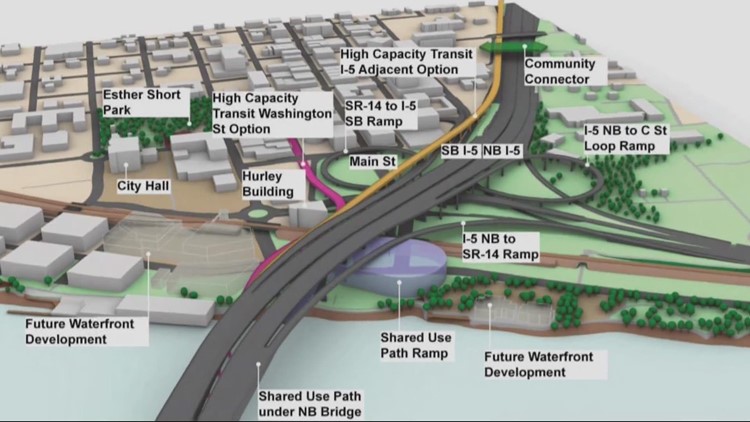PORTLAND, Ore. — The Interstate Bridge Replacement project is heading into the federal environmental review process, marking the start of a two-year period that will see the project go from a conceptual plan to a more concrete design for the new bridge.
The project team unveiled its proposed "Modified Locally Preferred Alternative" in May, a preliminary configuration recommendation that included a fixed crossing with no drawbridge, three main lanes and two auxiliary lanes in each direction, a scaled-down Hayden Island interchange and a light rail extension.
The "modified" part refers to the fact that the project is adapting the plan left over from its predecessor, the mothballed Columbia River Crossing. The old plan's federal approval is still valid, so modifying it will allow the project to go through a faster "supplemental" environmental review process.
The project team has spent the past couple months shopping the plan around to eight local boards and councils at agencies and governments like Trimet and Portland. All eight signed off on it, and each group reaffirmed its support at a Thursday morning meeting of the project's Executive Steering Group.
The environmental review process will take about about two years, according to project program administrator Greg Johnson, ideally ending with a federal green light for the project in 2024, which would allow construction to begin in late 2025 — although that will also require lining up billions of dollars in funding.
The plan is for the project cost to be evenly split between toll revenue, state funding and federal dollars. So far, only Washington has pledged $1 billion for the project. Johnson said the team plans to request the same amount from Oregon next year, and up to $2.5 billion from the federal government.
On Thursday afternoon, the bi-state legislative committee overseeing the project held a hearing to discuss the proposal and also came to a general consensus to move forward into the environmental process, although there were some concerns about the early design.
Some lawmakers voiced concerns about the planned use of tolling to fund part of the project, and raised questions about whether the proposed 8-lane crossing would be enough to handle the region's future traffic.
There were also concerns about the proposed height of the bridge, due to the U.S. Coast Guard's recent rejection of a proposal for 116 feet of vertical clearance as insufficient for river traffic (with the lift span raised, the current bridge has 178 feet of clearance).
Johnson said the Coast Guard's rejection wasn't a final determination, and noted that the old Columbia River Crossing was ultimately able to get permission for 116 feet after developing mitigation strategies for the small percentage of river traffic that would be affected. The new team plans to do the same.
Even so, Oregon State Rep. Khanh Pham said she was nervous about entering the federal environmental review process with a single 116-foot plan and no backup option in case the project ultimately failed to reach an agreement with the Coast Guard.



